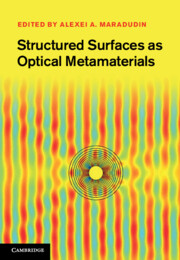Book contents
- Frontmatter
- Contents
- List of contributors
- Preface
- 1 Physics of extraordinary transmission through subwavelength hole arrays
- 2 Resonant optical properties of nanoporous metal surfaces
- 3 Optical wave interaction with two-dimensional arrays of plasmonic nanoparticles
- 4 Chirality and anisotropy of planar metamaterials
- 5 Novel optical devices using negative refraction of light by periodically corrugated surfaces
- 6 Transformation of optical fields by structured surfaces
- 7 Surface electromagnetic waves on structured perfectly conducting surfaces
- 8 Negative refraction using plasmonic structures that are atomically flat
- 9 Anomalous transmission in waveguides with correlated disorder in surface profiles
- 10 Cloaking
- 11 Linear and nonlinear phenomena with resonating surface polariton waves and their applications
- Index
- Plate section
- References
8 - Negative refraction using plasmonic structures that are atomically flat
Published online by Cambridge University Press: 01 June 2011
- Frontmatter
- Contents
- List of contributors
- Preface
- 1 Physics of extraordinary transmission through subwavelength hole arrays
- 2 Resonant optical properties of nanoporous metal surfaces
- 3 Optical wave interaction with two-dimensional arrays of plasmonic nanoparticles
- 4 Chirality and anisotropy of planar metamaterials
- 5 Novel optical devices using negative refraction of light by periodically corrugated surfaces
- 6 Transformation of optical fields by structured surfaces
- 7 Surface electromagnetic waves on structured perfectly conducting surfaces
- 8 Negative refraction using plasmonic structures that are atomically flat
- 9 Anomalous transmission in waveguides with correlated disorder in surface profiles
- 10 Cloaking
- 11 Linear and nonlinear phenomena with resonating surface polariton waves and their applications
- Index
- Plate section
- References
Summary
Introduction
All-angle negative refraction of electromagnetic waves [1, 2] has generated great interest because it provides the foundation for a wide range of new electromagnetic effects and applications, including subwavelength image formation [2] and a negative Doppler shift [1], as well as novel guiding, localization and nonlinear phenomena [3, 4]. There has been tremendous progress in achieving negative refraction in recent years using either dielectric photonic crystals [5–9] or metallic meta-materials [10–17]. For either approach, however, there is an underlying physical length scale that sets a fundamental limit [18]. Below such a length scale, the concept of an effective index no longer holds. For photonic crystals, it is the periodicity, which is smaller than but comparable to the operating wavelength of light [8]. For metallic meta-materials, it is the size of each individual resonant element. In the microwave wavelength range, constructing resonant elements that are far smaller than the operating wavelength is relatively straightforward. As one pushes towards shorter optical wavelengths, however, it becomes progressively more difficult to construct resonant elements at a deep subwavelength scale [15]. Moreover, in the optical wavelength range, the plasmonic effects of metals become prominent. The strong magnetic response of metallic structures, as observed in microwave and infrared wavelength ranges, may be fundamentally affected. It is therefore very desirable to accomplish all-angle negative refraction using structures that are flat at an atomic scale.
- Type
- Chapter
- Information
- Structured Surfaces as Optical Metamaterials , pp. 269 - 286Publisher: Cambridge University PressPrint publication year: 2011

